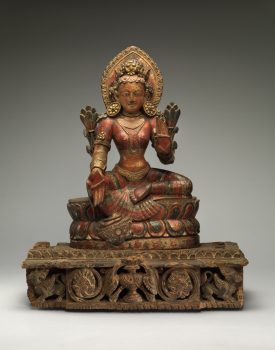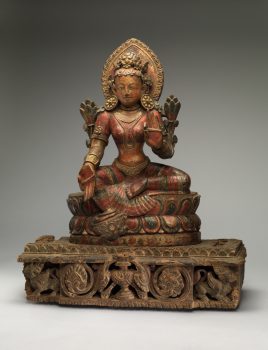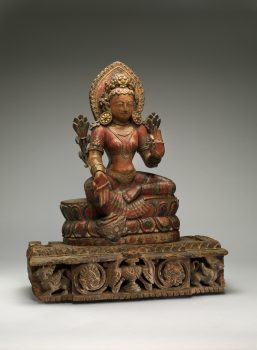Nepal
17th century
The right hand is extended in a giving gesture.
Nepal
17th century



Lakshmi is a goddess of wealth. Buddhists may identify her as Tara. Unequivocally, however, she is a lotus goddess. Her throne, pedestal, attributes, and tiara are all decorated with lotuses. A lotus naturally grows out of mud immediately after the monsoon rain and blossoms in autumn when rice is ready for harvesting. Thus, a lotus goddess is the goddess of wealth, of the harvest. The symbolism of the lotus, however, developed and is interpreted in many different ways in Buddhism and Hinduism.
A kind of energy that can be used, individually and collectively, to effect change.
In Buddhism gender is considered more fluid compared to some other religions. Certain traditions emphasize the importance of all genders in achieving enlightenment. The feminine is considered an embodiment of wisdom and the masculine is an embodiment of method.
Buddhists believe identity is not fixed but is variable and dependent on causes and conditions. It is a temporary, transitional, and ever-changing interplay of mental and physical elements.
Hindu gods (deva) are thought to be manifestations of the absolute, or Brahman. The goddesses (devi) are considered manifestations of the Great Mother Goddess (Mahadevi), who is seen as the counterpart to Brahman.
The Himalayan kingdoms of the Kathmandu Valley were significant centers of Buddhist culture. Nepalese kings, Buddhist institutions, and ordinary people patronized the vibrant art guilds. The artistic traditions of the regions are well-known in Tibetan areas and beyond, and Newar artists have always been in high demand throughout Tibetan regions and Inner Asia.
Get the latest news and stories from the Rubin, plus occasional information on how to support our work.